Engineering:McDonnell Douglas MD-11
| MD-11 | |
|---|---|
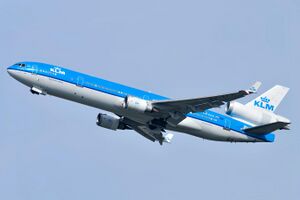
| |
| The MD-11, a stretched version of the DC-10 | |
| Role | Wide-body jet airliner |
| National origin | United States |
| Manufacturer | McDonnell Douglas (1988–97) Boeing Commercial Airplanes (1997–2000) |
| First flight | January 10, 1990 |
| Introduction | December 20, 1990 with Finnair |
| Status | In cargo service[lower-alpha 1] |
| Primary users | FedEx Express UPS Airlines Western Global Airlines Lufthansa Cargo (historical)[2] |
| Produced | 1988–2000[3] |
| Number built | 200 |
| Developed from | McDonnell Douglas DC-10 |
The McDonnell Douglas MD-11 is an American tri-jet wide-body airliner manufactured by American manufacturer McDonnell Douglas (MDC) and later by Boeing. Following DC-10 development studies, the MD-11 program was launched on December 30, 1986. Assembly of the first prototype began on March 9, 1988. Its maiden flight occurred on January 10, 1990, and it achieved Federal Aviation Administration (FAA) certification on November 8. The first delivery was to Finnair on December 7 and it entered service on December 20, 1990.
It retains the basic trijet configuration of the DC-10 with updated GE CF6-80C2 or PW4000 turbofan engines. Its wingspan is slightly larger than the DC-10 and it has winglets. Its MTOW is increased by 14% to 630,500 lb (286 t). Its fuselage is stretched by 11% to 202 ft (61.6 m) to accommodate 298 passengers in three classes over a range of up to 7,130 nautical miles [nmi] (13,200 km; 8,210 mi). It features a glass cockpit that eliminates the need for a flight engineer. The MD-11 failed to meet its range and fuel burn targets. The last of 200 aircraft was built in October 2000 after Boeing merged with McDonnell Douglas in 1997. Some MD-11 freighters were built, but many more are converted MD-11 passenger aircraft, many of which are still in service with cargo airlines.
Development

Origins
Although the MD-11 program was launched in 1986, McDonnell Douglas had started to search for a DC-10 derivative as early as 1976. Two versions were considered then: a DC-10-10 with a fuselage stretch of 40 feet (12 m) and a DC-10-30 stretched by 30 feet (9.1 m). The latter version would have been capable of transporting up to 340 passengers in a multi-class configuration, or 277 passengers and their luggage over 5,300 nautical miles (9,800 km; 6,100 mi). At the same time, the manufacturer was seeking to reduce wing and engine drag on the trijet. Another version of the aircraft was also envisaged, the "DC-10 global", aimed to counter the risks of loss of orders for the DC-10-30 that the Boeing 747SP and its range were causing. The DC-10 global would have incorporated more fuel tanks.[4]
While continuing their research for a new aircraft, McDonnell Douglas designated the program DC-10 Super 60, previously known for a short time as DC-10 Super 50. The Super 60 was to be an intercontinental aircraft incorporating many aerodynamic improvements in the wings, and a fuselage lengthened by 26 feet 8 inches (8.13 m) to allow for up to 350 passengers to be seated in a mixed-class layout, compared to 275 in the same configuration of the DC-10.[4]
Following more refinements, in 1979 the DC-10 Super 60 was proposed in three distinct versions like the DC-8. The DC-10-61 was designed to be a high-capacity medium-range aircraft. It would have a fuselage stretch of 40 feet (12 m) over the earlier DC-10 models, enabling it to carry 390 passengers in a mixed class or 550 passengers in an all-economy layout, similar to Boeing's later 777-300 and Airbus A340-600. Like the DC-8, the series 62 was proposed for long-range routes. It would feature a more modest fuselage stretch of 26 ft 7 in (8.10 m), along with an increased wingspan and fuel capacity. It would be capable of carrying up to 350 passengers (mixed class) or 440 passengers (all-economy), similar to the later Boeing 777-200 or the Airbus A330-300/A340-300/500. Finally, the series 63 would have incorporated the same fuselage as the DC-10-61 as well as the larger wing of the -62. After high-profile accidents in the 1970s, such as Turkish Airlines Flight 981 and American Airlines Flight 191, the trijet's reputation was seriously damaged by doubts regarding its structural integrity. For these reasons, and due to a downturn in the airline industry, all work on the Super 60 was stopped.[4]

In 1981, a Continental Airlines DC-10-10 (registration number N68048) was leased to conduct more research, particularly on the effects the newly designed winglets would have on aircraft performance. Different types of winglets were tested during that time in conjunction with NASA. McDonnell Douglas was again planning new DC-10 versions that could incorporate winglets and more efficient engines developed at the time by Pratt & Whitney (PW2037) and Rolls-Royce (RB.211-535F4). The manufacturer finally rationalized all these studies under the MD-EEE (Ecology-Economy-Efficiency) designation, which was later modified to the MD-100 following some more changes. The MD-100 was proposed in two versions: the Series 10, having an airframe shorter by 6 ft 6 in (1.98 m) compared to the DC-10 and seating up to 270 passengers in a mixed-class configuration; and the Series 20, incorporating a fuselage stretch of 20 ft 6 in (6.25 m) over the DC-10 and able to seat up to 333 passengers in the same kind of configuration as the Series 10. Both versions could be powered by the same engine families as the actual MD-11 plus the RB.211-600. However, the situation for the manufacturer, and the airline industry in general, did not look bright. No new DC-10 orders were received, and many observers and customers doubted that the manufacturer would stay in business much longer. Thus, the board of directors decided in November 1983 to once again cease all work on the projected new trijet.[4]
The following year no new orders for the DC-10 were received. The production line was kept active thanks to earlier orders from the U.S. Air Force for 60 KC-10A tankers. McDonnell Douglas was still convinced that a new derivative for the DC-10 was needed, as shown by the second-hand market for their Series 30 and the heavier DC-10-30ER version. Thus, in 1984 a new derivative aircraft version of the DC-10 was designated MD-11. From the very beginning, the MD-11X was conceived in two different versions. The MD-11X-10, based on a DC-10-30 airframe, offered a range of 6,500 nautical miles (12,000 km; 7,500 mi) with passengers. That first version would have had a maximum takeoff weight (MTOW) of 580,000 pounds (260,000 kg) and would have used CF6-80C2 or PW4000 engines. The MD-11X-20 was to have a longer fuselage, accommodating up to 331 passengers in a mixed-class layout, and a range of 6,000 nautical miles (11,000 km; 6,900 mi).[4]
As more orders for the DC-10 were received, McDonnell Douglas used the time gained before the end of DC-10 production to consult with potential customers and to refine the proposed new trijet. In July 1985, the board of directors authorized the Long Beach plant to offer the MD-11 to potential customers. At the time, the aircraft was still proposed in two versions, both with the same fuselage length, a stretch of 22 ft 3 in (6.78 m) over the DC-10 airframe, as well as the same engine choice as the MD-11X. One version would have a range of 4,780 nautical miles (8,850 km; 5,500 mi) with a gross weight of 500,000 pounds (230,000 kg) and transport up to 337 passengers, while the second would carry 331 passengers over 6,900 nautical miles (12,800 km; 7,900 mi). A year later, as several airlines had committed to the MD-11, the situation was looking optimistic. The aircraft was now a 320-seater baseline and defined as an 18 ft 7 in (5.66 m) stretch over the DC-10-30 powered by the new advanced turbofans offered by the major engine manufacturers giving it a range of 6,800 nautical miles (12,600 km; 7,800 mi). Other versions, such as a shortened ER with a range of 7,500 nautical miles (13,900 km; 8,600 mi), an all-cargo offering a maximum payload of 200,970 pounds (91,160 kg), and a Combi with a provision for ten freight pallets on the main deck, were proposed. Further growth of the aircraft was also foreseen, such as the MD-11 Advanced.[4]

The lack of innovation from McDonnell Douglas during the MD-11's design had been attributed to the company's declining cash flow, as it struggled with problems with its military contracts and declining orders for its commercial jets.[5] Limited company resources resulted in the MD-11 being developed as a refinement of the existing DC-10, in contrast to rivals Airbus and Boeing who during this period developed all-new aircraft designs that would become the Airbus A330/A340 and Boeing 777. As a trijet, the MD-11 was less fuel-efficient but had a greater range than its mid-size widebody contemporaries which were twinjets (the existing Boeing 767 and the upcoming Airbus A330 and Boeing 777).[6] Aerospace consultant Scott Hamilton, in a 2014 article, said that the MD-11 was "classically ill-timed" as "it came at the end of the three- or four-engine era, just ahead of the real move to ETOPS with the 777".[7] McDonnell Douglas's initiative to "outsource everything but design, final assembly, and flight testing and sales of the MD-11" was also seen as contributing to the end of their commercial airline business.[8]
Launch and costs
On December 30, 1986, McDonnell Douglas launched the MD-11 with commitments for 52 firm orders and 40 options[9] in three different versions (passenger, combi and freighter) from ten airlines (Alitalia, British Caledonian, Dragonair, Federal Express, Finnair, Korean Air, Scandinavian Airlines, Swissair, Thai Airways International, and VARIG)[9] and two leasing companies (Guinness Peat Aviation and Mitsui).[9] Orders from Dragonair, Scandinavian, and UTA,[9] an undisclosed customer, were canceled by 1988.
In 1987, the program was to cost $1.5 billion (equivalent to $2.95 billion in 2019[10]) with $500 million for development and almost $1 billion for tooling and inventory. The first 52 firm orders totaled $5 billion, or $95 million each, while the A340 sold for $67 million.[11] At certification in 1990, $2.5 billion were invested in initial production inventory, and $700 million for engineering, tools, and flight testing. While it was selling for $100 million, the initial MD-11 jets cost $120 to $150 million to produce but this was to reduce to $90 million with manufacturing experience over the program life for an 11% gross profit margin, less than the 15% to 20% Boeing obtains.[12]
In 1992, the $1.7 billion development cost was to be spread over the first 301 aircraft produced for $100 million each.[13] In 1995, because costs and revenues could not be reasonably estimated over the program life, MDC took a pre-tax charge of $1.838 billion (~$2.87 billion in 2019[10]) for deferred production costs and for reduced support and tooling value.[14] In 1999, the unit cost was $132-$147.5 million[14] (equivalent to $194-$217 million in 2019 dollars)[10].
Production and performance issues
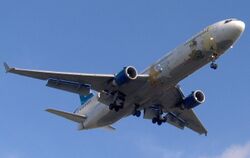
Assembly of the first MD-11 began on March 9, 1988, and the mating of the fuselage with wings occurred in October of that year. The first flight was originally planned to occur in March 1989, but numerous problems with the manufacturing, delays with suppliers producing essential components, and labor industrial actions delayed the ceremonial rollout of the prototype until September of that year. The following months were used to prepare the prototype for its maiden flight, which finally happened on January 10, 1990. The first two aircraft manufactured were intended for FedEx and thus, were already fitted with the forward side cargo door. They remained with the manufacturer as test aircraft until 1991 before being completely converted to freighters and delivered to their customer. FAA certification was achieved on November 8, 1990, while the European Joint Aviation Authorities (JAA) certified the MD-11 on October 17, 1991, after approximately 200 separate issues were resolved.[4] Fuselage sections for the DC-10, KC-10, and MD-11 were built by General Dynamics' Convair Division.[15] Yugoslav Airlines, already flying several DC-10s, became the first customer of the MD-11. Three aircraft were manufactured but were never delivered due to the Yugoslav Wars. The first MD-11 was delivered to Finnair on December 7, 1990, and it accomplished the first revenue service by an MD-11 on December 20, 1990, carrying passengers from Helsinki to Tenerife in the Canary Islands. MD-11 service in the U.S. was inaugurated by Delta Air Lines the following year.
It was during this period that flaws in the MD-11's performance became apparent. It failed to meet its targets for range and fuel burn.[16] American Airlines in particular was unimpressed with the 19 MD-11s that it received, as was Singapore Airlines who canceled their order for 20 MD-11s and instead ordered 20 Airbus A340-300s. American Airlines cited problems with the performance of the engines and airframe, while Singapore Airlines stated that the MD-11 could not operate on the airline's long-haul routes.[17] Pre-flight estimates indicated that the P&W-powered MD-11 was to have a 7,000 nautical miles (13,000 km; 8,100 mi) range with 61,000 pounds (28 t) of payload. With the Phase 1 drag reduction in place, the aircraft could only achieve its full range with 48,500 pounds (22.0 t) of payload, or a reduced range of 6,493 nautical miles (12,025 km; 7,472 mi) with a full payload.[18]
In 1990, McDonnell Douglas, along with Pratt & Whitney and General Electric began a modification program known as the Performance Improvement Program (PIP) to improve the aircraft's weight, fuel capacity, engine performance, and aerodynamics. McDonnell Douglas worked with NASA's Langley Research Center to study aerodynamic improvements.[19] The PIP lasted until 1995 and recovered the range for the aircraft. However, by this point, sales of the MD-11 had already been significantly impacted.[16] In 1995, American Airlines sold its 19 MD-11s to FedEx, as the PIP program was not sufficient for the aircraft to fly the DFW-Hong Kong route.[7]
After McDonnell Douglas merged with Boeing in 1997, the unified company decided that MD-11 production would continue exclusively with the freighter variant. In 1998, Boeing announced it would end MD-11 production after filling orders on hand.[20] The last passenger MD-11 built was delivered to Sabena in April 1998.[21] Assembly of the last two MD-11s were completed in August and October 2000; they were delivered to Lufthansa Cargo on February 22 and January 25, 2001, respectively.[3] Production ended because of a lack of sales, resulting from internal competition from the Boeing 767 and 777, as well as external competition from the Airbus A330/A340.
The MD-11 was assembled at McDonnell Douglas's Douglas Products Division in Long Beach, California (later Boeing's facility). McDonnell Douglas originally projected that it would sell more than 300 MD-11 aircraft, but only 200 were built.
Design

The MD-11 is a medium- to long-range widebody airliner, with two engines mounted on underwing pylons and a third engine at the base of the vertical stabilizer. It is based on the DC-10 but features a stretched fuselage, increased wingspan with winglets, refined airfoils on the wing and tailplane, new engines, and increased use of composites.[3] The winglets are credited with improving fuel efficiency by about 2.5%.[22] The MD-11 has a smaller empennage than the DC-10 it is based upon.[23]
The MD-11 features a two-crew cockpit that incorporates six interchangeable CRT units and advanced Honeywell VIA 2000 computers. The cockpit design is called Advanced Common Flightdeck (ACF)[3] and is shared with the Boeing 717. Flight deck features include an Electronic Instrument System, a dual Flight Management System, a Central Fault Display System, and a Global Positioning System. Category IIIb automatic landing capability for bad-weather operations and Future Air Navigation Systems are available.[3]
The MD-11 was one of the first commercial designs to employ a computer-assisted pitch stability augmentation system that featured a fuel ballast tank in the tailplane, and a partly computer-driven horizontal stabilizer. Updates to the software package made the airplane's handling characteristics in manual flight similar to those of the DC-10, despite a smaller tailplane to reduce drag and increase fuel efficiency.[citation needed]
The MD-11 incorporates hydraulic fuses not included in the initial DC-10 design, to prevent catastrophic loss of control in the event of hydraulic failure such as happened on United Airlines Flight 232.[24]
Variants
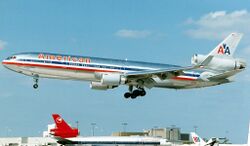
The MD-11 was manufactured in five variants.
- MD-11 (131 built): the passenger variant, was produced from 1988 to 1998. It was the first version on offer at the aircraft's launch in 1986 and was delivered to American Airlines (19), Delta Air Lines (17), Swissair (16), Japan Airlines (10), KLM (10), and other airlines with fewer aircraft.[3]
- MD-11C (five built): this combi aircraft was the third variant on offer at launch in 1986 and was designed to accommodate both passengers and freight on the main deck, which featured a rear cargo compartment for up to ten pallets, each measuring 88 by 125 inches (2.2 m × 3.2 m) or 96 by 125 inches (2.4 m × 3.2 m). The main deck cargo compartment was accessible by a large rear port-side cargo door, which measured 160 by 102 inches (4.1 m × 2.6 m). The main deck cargo volume was 10,904 cubic feet (308.8 m3). Additional freight was also carried in below-deck compartments. The MD-11C could also be configured as an all-passenger aircraft. All five aircraft were manufactured between 1991 and 1992 and delivered to Alitalia, the only customer for that variant.[3] In 2005 and 2006 the airline converted them to full-freighter configurations to be operated by Alitalia's cargo division. Following that division's closure, the five aircraft were returned to their lessor in January 2009.[25]
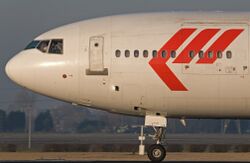
- MD-11CF (six built): the Convertible Freighter variant was launched in 1991 by an order from Martinair for three aircraft plus two options. The MD-11CF features a large forward port-side cargo door (140 by 102 inches (3.6 m × 2.6 m)) located between the first two passenger doors and can be used in an all-passenger or in an all-cargo configuration. As a freighter, it can transport 26 pallets of the same dimensions (88 by 125 inches (2.2 m × 3.2 m)) or 96 by 125 inches (2.4 m × 3.2 m)) as for the MD-11C and MD-11F for a main-deck cargo volume of 14,508 cubic feet (410.8 m3) and offers a maximum payload of 196,928 pounds (89,325 kg). All six MD-11CFs were delivered to Martinair (four) and World Airways (two) in 1995. The two World Airways aircraft were converted to freight-only in 2002.[3]
- MD-11ER (five built): the Extended Range version was launched by the manufacturer at the Singapore Air Show in February 1994.[9] The MD-11ER incorporates all the Performance Improvement Program (PIP) options, including a maximum takeoff weight of 630,500 pounds (286,000 kg) and an extra fuel tank of 3,000 US gallons (11,000 L)) in the forward cargo hold[26] to offer a range of 7,240 nautical miles (13,410 km; 8,330 mi), an increase of 400 nautical miles (740 km; 460 mi) over the standard passenger variant. MD-11ERs were delivered between 1995 and 1997 to Garuda Indonesia (three) and World Airways (two). As of February 2007, only one Finnair MD-11ER has been converted to MD-11 with the removal of the extra fuel tank.[3]
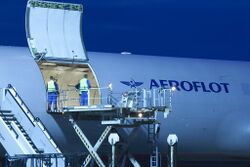
- MD-11F (53 built): The freight transport aircraft was the second variant on offer at launch in 1986 and was the last and longest (1988–2000) manufactured version. The all-cargo aircraft features the same forward port-side cargo door (140 by 102 inches (3.6 m × 2.6 m)) as the MD-11CF, a main-deck volume of 15,530 cubic feet (440 m3), a maximum payload of 200,151 pounds (90,787 kg) and can transport 26 pallets of the same dimensions (88 by 125 inches (2.2 m × 3.2 m) or 96 by 125 inches (2.4 m × 3.2 m)) as for the MD-11C and MD-11CF. The MD-11F was delivered between 1991 and 2001 to FedEx Express (22), Lufthansa Cargo (14), and other airlines with fewer aircraft.[3]
- MD-11 Boeing Converted Freighter (BCF) – Boeing and its group of international affiliates offer a conversion of used passenger airliners into freighters. The MD-11BCF is one of the models offered.[27]
Note: Some or all the features of the MD-11ER, including the higher MTOW of 630,500 pounds (286.0 t), part or all of the PIPs aerodynamic improvements packages and composite panels were fitted to later-built MD-11s (except the extra fuel tank), and could be retrofitted to any of the variants, except for the PIP Phase IIIB larger aft-engine intake. Some airlines, such as Finnair, Martinair, and FedEx have made the structural changes required to allow their aircraft to have the higher MTOW. Swissair's 16 newest aircraft were retrofitted with all the features except for the extra fuel tank and were so-designated MD-11AH for Advanced Heavy.[3]
Proposed tanker version
After McDonnell Douglas did the KDC-10 conversion for the Royal Netherlands Air Force in 1992, they proposed a tanker/transport version of the MD-11CF which had the in-house designation KMD-11. McDD offered either conversion of second-hand aircraft (KMD-11) or new built aircraft (KC-10B), the proposed KMD-11 offered 35,000 lbs more cargo capacity and 8,400 lbs more transferable fuel than the KC-10A. It was offered to the RNAF and Royal Saudi Air Force (RSAF) in the 1990s and the Royal Australian Air Force (RAAF) in the early 2000s.[28]
Undeveloped variants
In 1993, 1995, and again in 1996, McDonnell Douglas performed studies on the feasibility of a twin-engine jet using MD-11 components, but nothing came of any of them.[29][30][31] In August 1997, just after the merger with Boeing, a presentation was made pitching an MD-11 twin with a new Boeing wing to fill the gap between the 767 and the 777, but again the proposal came to nothing.[31]
After ending the MD-12 program, McDonnell Douglas focused on 300–400-seat MD-11 derivatives. At the 1996 Farnborough International Air Show, the company presented plans for a new tri-jet with high seating and long range named "MD-XX".[32] It was offered in the MD-XX Stretch and MD-XX LR versions. The MD-XX Stretch version was to have a longer fuselage than the MD-11 and seat 375 in a typical three-class arrangement. The MD-XX LR was to have a longer range and be the same length as the MD-11; it was to have typical three-class seating for 309. However, the MDC board of directors decided to end the MD-XX program in October 1996, because the financial investment was too large for the company.[33]
Operators
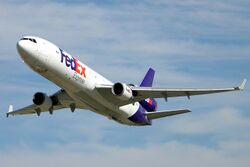
As of October 2021, there are 116 MD-11s in commercial service with cargo operators FedEx Express (57), UPS Airlines (42), and Western Global Airlines (17).[34]
Most of the airlines that ordered the MD-11 for their long-haul passenger flights had replaced it with Airbus A330, A340, and Boeing 777 aircraft by the end of 2004. Some carriers converted their MD-11s to freighters such as China Eastern Airlines and Korean Air. Korean Air announced as early as December 1994 its intention to convert its five passenger MD-11s to freighters for medium-range cargo routes.[35] In 1995, American Airlines agreed to sell its 19 aircraft to FedEx, with the first MD-11 being transferred in 1996.[36] Japan Airlines (JAL) announced the replacement of its 10 MD-11s in 2000; these aircraft were being converted into freighters and sold to UPS in 2004.[3]
In February 2007, TAM Linhas Aéreas began operating the first of three leased passenger MD-11s, in a deal arranged by Boeing as an interim solution for TAM to quickly be able to operate newly granted intercontinental routes while waiting for four Boeing 777-300ERs to be delivered from late 2008.[37] The last MD-11 was retired from TAM's fleet in July 2009, which ended its use by Brazil ian airlines (Varig, VASP, and TAM).[38]
In May 2007, Finnair announced the sale of their last two MD-11s to Aeroflot-Cargo to become part of the Russian airline cargo fleet in 2008 and 2009.[39] KLM was the last airline to operate scheduled passenger flights with the passenger version of the MD-11. The final scheduled flight took place on October 26, 2014, from Montréal to Amsterdam,[40] followed by three special roundtrip flights on November 11, 2014.[41]
Two MD-11s were also operated in a VIP configuration, one by Saudia Royal Flight[42] for members of the Royal family, and one by Mid East Jet for ASACO Aviation; both are now stored.[43]
Lufthansa Cargo retired their last MD-11 on October 17, 2021.[44]
Accidents and incidents
As of June 2017, the MD-11 has been involved in 30 aviation incidents,[45] including nine hull-loss accidents with 244 fatalities.[46][47]
Notable accidents and incidents
- On April 6, 1993, China Eastern Airlines Flight 583, an MD-11 went into severe oscillations when a crew member accidentally deployed the slats while cruising over the Pacific Ocean near the Aleutian Islands. Two passengers were seriously injured and later died.[48][49]
- On July 31, 1997, FedEx Express Flight 14, MD-11 N611FE, crashed during a landing at Newark Liberty International Airport, New Jersey. The aircraft flipped onto its back and subsequently burned, following a landing attempt from an unstabilized flare. The five occupants survived with injuries.[50]
- On September 2, 1998, Swissair Flight 111, MD-11 HB-IWF, crashed into the Atlantic Ocean near Halifax, Nova Scotia while en route from New York City to Geneva, Switzerland. All 229 people on board perished. The cause of the crash was determined to have been a fire caused by improper wiring of passenger entertainment system units added by Swissair. The fire started at the front of the aircraft and quickly grew uncontrollable, attributed partly to the poor flame retardant properties of its metalized mylar insulation.[51]
- On April 15, 1999, Korean Air Cargo Flight 6316, MD-11 registration number HL7373, crashed shortly after takeoff while operating cargo flight KE6316 from Shanghai Hongqiao International Airport to Seoul. After takeoff, the flight was cleared to climb to 4,900 feet (1,500 meters). The aircraft climbed to 4,500 ft (1,400 m). Due to confusion on the flight deck, the captain thought the aircraft was too high and needed to descend. The captain pushed the control column abruptly forward, causing the MD-11 to enter a rapid descent from which it could not be recovered. All three occupants on board and five people on the ground were killed.[52]
- On August 22, 1999, China Airlines Flight 642, an MD-11 operated by subsidiary Mandarin Airlines, crashed while landing at Hong Kong International Airport during typhoon Sam that exceeded its crosswind specifications, also flipping onto its back and burning. Three passengers were killed.
- On October 17, 1999, FedEx Express Flight 87, MD-11 N581FE, was written off after landing at Subic Bay International Airport, Philippines. The aircraft was operating from Shanghai Hongqiao International Airport. Upon landing, the aircraft rolled down the whole length of the runway before plunging into the bay where it was completely submerged except for the cockpit. An excessive approach and landing speed were pointed out as probable cause of the accident.[53]
- On March 23, 2009, FedEx Express Flight 80, MD-11F N526FE, crashed at Narita International Airport, Japan while landing in windy conditions. Airport surveillance video showed the aircraft becoming airborne again after the first touchdown, then impacting nose-first the second time and turning onto its left side, erupting into flames; the impact flipped the aircraft upside-down. The aircraft finally came to rest some distance left of the runway. The two flight crew members were killed.[54][55]
- On November 28, 2009, Avient Aviation Flight 324, MD-11F Z-BAV (c/n 48408), crashed on takeoff from Shanghai Pudong International Airport on a flight to Bishkek-Manas International Airport, Kyrgyzstan with the loss of three lives.[56] The aircraft was written off.[57]
- On July 27, 2010, Lufthansa Cargo Flight 8460, an MD-11F, crash-landed at King Khalid International Airport in Riyadh, Saudi Arabia. The captain and first officer evacuated the aircraft with injuries. This incident is very similar to FedEx Flight 80 and FedEx Flight 14.[58]
- On February 13, 2016, Western Global Airlines Flight 4425 was involved in a stowaway incident that was discovered when the plane had stopped in Harare Airport, Zimbabwe for a fuel stop en route to King Shaka International Airport, South Africa from Munich, Germany . The deceased stowaway was located in the plane’s cargo hold after ground staff at Harare noticed blood dripping from one of the MD-11’s cargo doors. The crew initially stated that they believed the blood to have come from a bird strike which had been noticed by ground staff at Munich Airport earlier in the plane's journey, but the body of a man who had stowed away on the flight was discovered shortly after the plane and its crew were seized by Zimbabwean authorities.[59][60][61]
- On June 6, 2016, UPS Airlines Flight 61, MD-11F N277UP suffered a runway excursion and nose gear collapse in a takeoff accident at Seoul-Incheon International Airport (ICN). Takeoff from runway 33L was aborted and the aircraft continued past the end of the runway. The nose gear collapsed and the nos. 1 and 3 engines contacted the grass. The flight was bound for Ted Stevens Anchorage International Airport. All 4 crew members survived without injury. The aircraft was written off.[62]
Safety problems
The MD-11 had problems with its flight control systems that have resulted in multiple accidents and incidents since the aircraft's introduction.[63] The initial design of the slat/flap lever in the cockpit left it prone to being accidentally dislodged by a crew in flight. The defect has been corrected since 1992.[64] In the early 2000s, Boeing improved the flight control software at the urging of the FAA to reduce the possibility of violent unintentional pitch movements.[63]
To improve fuel efficiency, McDonnell Douglas designed the MD-11's center of gravity to be much farther aft than that of other commercial aircraft. There was also a fuel-ballast tank in the MD-11's horizontal stabilizer since its tailplane was smaller than the DC-10's to improve fuel efficiency, but this was found to inhibit the MD-11's crosswind performance.[6] These design features, coupled with standard landing speeds 20–30 knots (35–55 km/h) faster than those of comparable aircraft, significantly reduce the MD-11's margin for error during the takeoff and landing phases, making it more difficult to handle than the smaller DC-10.[7][65] Several operators have introduced special training to assist crews in safely handling the MD-11's critical phases of flight.[58]
Specifications

| Variant | MD-11 | MD-11F |
|---|---|---|
| Cockpit crew | Two | |
| Main deck | 298: 16F + 56J + 226Y or 323: 34J + 289Y or 410Y, 10-abreast[67] |
26 96 × 125" pallets or 34 88 × 108" pallets 21,530 cu.ft / 609.7 m³ |
| Lower deck | 32 LD3 | |
| Length | GE: 202 ft 2 in / 61.6 m, PW: 200 ft 11 in / 61.2 m | |
| Width | 19 ft 9 in / 6.0 m fuselage, 225 in (572 cm) cabin | |
| Wing | 170 ft 6 in / 51.97 m span, 3,648 sq ft (338.9 m2) area[lower-alpha 2][67] | |
| Height | 57 ft 11 in (17.65 m)[67] | |
| MTOW | 602,500 lb / 273,294 kg, ER: 630,500 lb / 285,988 kg | |
| Max. payload | 116,025 lb / 52,632 kg | 202,733 lb / 91,962 kg |
| Fuel capacity | 38,615 US gal / 146,173 L, 258,721 lb / 117,356 kg[lower-alpha 3] | |
| OEW | 283,975 lb / 128,808 kg | 248,567 lb / 112,748 kg |
| Engines (×3) | PW4460/62 / General Electric CF6-80C2D1F | |
| Maximum thrust (×3) | 62,000 lbf (280 kN) / 61,500 lbf (274 kN)[67] | |
| Speed | Mach 0.83 (549 kn; 1,017 km/h; 632 mph)[convert: invalid option] cruise[68] Mach 0.88 (582 kn; 1,078 km/h; 670 mph)[convert: invalid option] MMo[69] | |
| Range | 6,725 nmi (12,455 km; 7,739 mi)[lower-alpha 4][67] | 3,592 nmi (6,652 km; 4,134 mi)[lower-alpha 5][68] |
| Ceiling | 43,000 ft (13,100 m)[69] | |
| Takeoff distance at MTOW | 9,725 ft (2,964 m), ER: 10,800 ft (3,292 m)[68] | |
Deliveries
| 1990 | 1991 | 1992 | 1993 | 1994 | 1995 | 1996 | 1997 | 1998 | 1999 | 2000 | 2001 | Total |
|---|---|---|---|---|---|---|---|---|---|---|---|---|
| 3 | 31 | 42 | 36 | 17 | 18 | 15 | 12 | 12 | 8 | 4 | 2 | 200 |
See also
Related development
Aircraft of comparable role, configuration and era
Related lists
Notes
References
Citations
- ↑ "KLM's MD-11 History Comes To An End" (Press release). KLM. 2014-10-26. Retrieved 2019-02-04.
- ↑ "Tschüss: Lufthansa Cargo Says Goodbye To Europe's Last MD-11". 18 October 2021. https://simpleflying.com/lufthansa-cargo-last-md-11-retired/.
- ↑ 3.00 3.01 3.02 3.03 3.04 3.05 3.06 3.07 3.08 3.09 3.10 3.11 Steffen, Arthur (January 2002). McDonnell Douglas MD-11: A Long Beach Swansong. Midland. ISBN 1-85780-117-2.
- ↑ 4.0 4.1 4.2 4.3 4.4 4.5 4.6 Marriott, Leo (December 1992). McDonnell Douglas MD-11 (Modern Civil Aircraft: 12). Howell Press. ISBN 0-7110-2071-X.
- ↑ Pasztor, Andy (September 19, 2000). "Jet's Troubled History Raises Issues For the FAA and the Manufacturer". iasa.com.au The Wall Street Journal. http://www.iasa.com.au/folders/sr111/forbidding.html.
- ↑ 6.0 6.1 Brown, David Parker (August 24, 2012). "KLM Starts to Say Goodbye to the MD-11". AirlineReporter.com. http://www.airlinereporter.com/2012/08/klm-prepares-to-say-good-bye-to-the-md-11/.
- ↑ 7.0 7.1 7.2 Reed, Ted (November 15, 2014). "Good Bye MD-11 -- Too Bad Nobody Ever Loved You". Forbes. https://www.forbes.com/sites/tedreed/2014/11/15/good-bye-md-11-too-bad-nobody-ever-loved-you/.
- ↑ Tkacik, Maureen (18 September 2019). "Crash Course". The New Republic. https://newrepublic.com/article/154944/boeing-737-max-investigation-indonesia-lion-air-ethiopian-airlines-managerial-revolution.
- ↑ 9.0 9.1 9.2 9.3 9.4 "McDonnell-Douglas MD-11". pilotfriend.com. http://www.pilotfriend.com/photo_albums/timeline/airliners/33.htm.
- ↑ 10.0 10.1 10.2 Thomas, Ryland; Williamson, Samuel H. (2020). "What Was the U.S. GDP Then?". MeasuringWorth. http://www.measuringworth.com/datasets/usgdp/. Retrieved September 22, 2020 United States Gross Domestic Product deflator figures follow the Measuring Worth series.
- ↑ Steven Greenhouse (Feb 22, 1987). "Dicey Days at McDonnell Douglas". The New York Times. https://www.nytimes.com/1987/02/22/business/dicey-days-at-mcdonnell-douglas.html.
- ↑ Ralph Vartabedian (November 9, 1990). "A Big Day for the MD-11 : Aerospace: The government certifies the aircraft". Los Angeles Times. http://articles.latimes.com/1990-11-09/business/fi-4259_1_program-mcdonnell-douglas.
- ↑ Steven Greenhouse (Oct 21, 1992). "McDonnell Said to Plan Cut in Output". The New York Times. https://www.nytimes.com/1992/10/21/business/company-news-mcdonnell-said-to-plan-cut-in-output.html.
- ↑ 14.0 14.1 "Boeing MD-11". Civil Aircraft Forecast. Forecast International. April 2002. https://www.forecastinternational.com/archive/disp_old_pdf.cfm?ARC_ID=316.
- ↑ Hayes, Thomas C. (March 15, 1989). "Deal Set by McDonnell And General Dynamics". The New York Times. https://www.nytimes.com/1989/03/15/business/company-news-deal-set-by-mcdonnell-and-general-dynamics.html.
- ↑ 16.0 16.1 Norris, Guy; Wagner, Mark (1999). Douglas Jetliners. MBI Publishing. ISBN 0-7603-0676-1.
- ↑ "SIA orders A340s and abandons MD-11 purchase". Flight International. 7–13 August 1991. https://www.flightglobal.com/pdfarchive/view/1991/1991%20-%202038.html?search=SIA%20orders%20A340s.
- ↑ Norris, Guy (7–13 August 1991). "Update fails to save SIA MD-lls". Flight International. https://www.flightglobal.com/pdfarchive/view/1991/1991%20-%202038.html?search=Update%20fails%20to%20save%20SIA%20MD11s.
- ↑ Langley RC Computational Fluid Dynamics .
- ↑ "Boeing Announces Phase-Out of MD-11 Jetliner Program". Boeing. June 3, 1998. http://boeing.mediaroom.com/1998-06-03-Boeing-Announces-Phase-Out-of-MD-11-Jetliner-Program.
- ↑ "McDonnell Douglas MD-11 - MSN 48780 - ET-AND". airfleets.net. http://www.airfleets.net/ficheapp/plane-md11-48780.htm.
- ↑ Assessment of wingtip modifications to increase the fuel efficiency of Air Force aircraft, (2007) National Academies Press, p. 40. ISBN:0-309-10497-1.
- ↑ Noland, David (May 11, 2010). "What's Wrong With the MD-11 Airplane?". Popular Mechanics. http://www.popularmechanics.com/flight/a5702/whats-wrong-with-the-md11/.
- ↑ Fielder, John H. and Douglas Birsch. The DC-10 Case: A Study in Applied Ethics, Technology, and Society, p. 261. SUNY Press, 1992. ISBN:0-7914-1087-0.
- ↑ "Air France-KLM buys into streamlined Alitalia". Air Cargo News, 15 January 2009.
- ↑ "Garuda Indonesia Takes Delivery of First MD-11ER". December 17, 1996. https://www.thefreelibrary.com/Garuda+Indonesia+Takes+Delivery+of+First+MD-11ER-a018958313.
- ↑ World's First 767-300 Boeing Converted Freighter Goes to ANA Boeing
- ↑ "Too Big For Its Own Good: Why A MD-11 Based Tanker Was Never Built". 8 January 2016. https://avgeekery.com/why-wasnt-there-a-md-11-based-tanker/. Retrieved 22 February 2023.
- ↑ Norris, Guy (January 25, 1995). "Douglas concentrates on proposal for MD-11 Twin". FlightGlobal. https://www.flightglobal.com/news/articles/douglas-concentrates-on-proposal-for-md-11-twin-22513/.
- ↑ Flight International, 25–31 January 1995
- ↑ 31.0 31.1 Thomas, Geoffrey (2023-02-08). "How McDonnell Douglas missed the Big Twin and disappeared" (in en-AU). https://www.airlineratings.com/news/mcdonnell-douglas-missed-big-twin-disappeared/.
- ↑ "McDonnell Douglas Unveils New MD-XX Trijet Design." McDonnell Douglas, September 4, 1996.
- ↑ Arthur 2002, pp. 92–94.
- ↑ "McDonnell Douglas MD-11 Production list". https://www.airfleets.net/listing/md11-1-statasc.htm.
- ↑ O'Toole, Kevin; Kingsley-Jones, Max (September 18, 1996). "New master of the loads". FlightGlobal. https://www.flightglobal.com/news/articles/new-master-of-the-loads-11647/.
- ↑ "FedEx takes American's MD-11 fleet". Flight International, April 19, 1995.
- ↑ "Brazil's TAM introduces first MD-11". Flight International, February 5, 2007.
- ↑ Sousa, Joselito (2016-03-09). "Por onde andariam os McDonnell Douglas MD11 da TAM?" (in pt). Aviões e Músicas. http://www.avioesemusicas.com/por-onde-andariam-os-mcdonnell-douglas-md11-da-tam.html.
- ↑ "Finnair sells Two Boeing MD-11 aircraft". asiatraveltips.com. May 17, 2007. http://www.asiatraveltips.com/news07/175-Finnair.shtml.
- ↑ "The MD-11 makes its final scheduled passenger flight". USA Today
- ↑ "Win two last tickets for KLM's MD-11 Farewell Flights on 11 November". KLM.com
- ↑ Saudi Arabian Royal Flight . CH-Aviation
- ↑ Asasco Aviation . CH-Aviation
- ↑ "Newsroom - Lufthansa Cargo". https://lufthansa-cargo.com/en/newsroom#/pressreleases/the-last-md-11f-leaves-lufthansa-cargo-3137028.
- ↑ McDonnell Douglas MD-11 incidents. Aviation-Safety.net, June 28, 2017.
- ↑ McDonnell Douglas MD-11 hull-losses. Aviation-Safety.net, June 28, 2017.
- ↑ McDonnell Douglas MD-11 Statistics. Aviation-Safety.net, June 28, 2017.
- ↑ "National Transportation Safety Board Aircraft Accident Report Inadvertent In-Flight Slat Deployment China Eastern Airlines Flight 583 McDonnell Douglas MD-11, B-2171 950 Nautical Miles South of Shemya, Alaska April 6, 1993". National Transportation Safety Board. October 27, 1993. https://reports.aviation-safety.net/1993/19930406-2_MD11_B-2171.pdf.
- ↑ "ASN Aircraft accident McDonnell Douglas MD-11 B-2171 Shemya, AK." Aviation Safety Network. Retrieved June 15, 2009.
- ↑ "National Transportation Safety Board Aircraft Accident Report Crash During Landing Federal Express, Inc. McDonnell Douglas MD-11, N611FE Newark International Airport Newark, New Jersey July 31, 1997". National Transportation Safety Board. July 25, 2000. http://libraryonline.erau.edu/online-full-text/ntsb/aircraft-accident-reports/AAR00-02.pdf.
- ↑ "Aviation Investigation Report In-Flight Fire Leading to Collision with Water Swissair Transport Limited McDonnell Douglas MD-11 HB-IWF Peggy's Cove, Nova Scotia 5 nm SW 2 September 1998". Transportation Safety Board of Canada. http://www.tsb.gc.ca/eng/rapports-reports/aviation/1998/a98h0003/a98h0003.pdf.
- ↑ Accident summary, Korean Air HL7373. aviation-safety.net
- ↑ Accident summary, Federal Express N581FE. aviation-safety.net
- ↑ "FedEx plane crashes, explodes at Tokyo's Narita". Reuters. March 22, 2009. https://www.reuters.com/article/us-japan-plane-idUSTRE52L1P920090322.
- ↑ "Aircraft Accident Investigation Report Federal Express Corporation N526FE". Japan Transport Safety Board. April 26, 2013. http://www.mlit.go.jp/jtsb/eng-air_report/N526FE.pdf.
- ↑ Hradecky, Simon (November 28, 2009). "Crash: Avient Aviation MD11 at Shanghai on Nov 28th 2009, overran runway on takeoff". The Aviation Herald. http://www.avherald.com/h?article=423638d8&opt=0.
- ↑ "Accident description". Aviation Safety Network. http://aviation-safety.net/database/record.php?id=20091128-0.
- ↑ 58.0 58.1 Flottau, Jens. "Hard Landing: Lufthansa Cargo crash could reopen questions on pilot proficiency". Aviation Week & Space Technology. 172(29) August 2, 2010, pp. 41–42. (Registration required).
- ↑ "Blood dripping from plane leads to body" (in en). IOL News. 15 February 2016. https://www.iol.co.za/news/africa/blood-dripping-from-plane-leads-to-body-1984427.
- ↑ Hradecky, Simon (16 February 2016). "News: A Western Global MD11 in Harare on Feb 14th 2016 and the results of the fuel stop". The Aviation Herald. https://avherald.com/h?article=49409531.
- ↑ "Western Global Airlines Issues Update on Aircraft Situation" (in en). Business Wire. 16 February 2016. https://www.businesswire.com/news/home/20160216006782/en.
- ↑ Ranter, Harro. "ASN Aircraft accident McDonnell Douglas MD-11F N277UP Seoul-Incheon International Airport (ICN)". https://aviation-safety.net/database/record.php?id=20160606-0.
- ↑ 63.0 63.1 Pasztor, Andy; Murphy, John (March 24, 2009). "FedEx Jet Has Control Issues". The Wall Street Journal. https://www.wsj.com/articles/SB123776874104009733.
- ↑ "Letters 1993". https://www.ntsb.gov/Recs/letters/1993/A93_81_83.pdf.
- ↑ What's Wrong with the MD-11? Popular Mechanics
- ↑ "MD-11 Airplane Characteristics for Airport Planning". Boeing. May 2011. http://www.boeing.com/resources/boeingdotcom/commercial/airports/acaps/md11.pdf.
- ↑ 67.0 67.1 67.2 67.3 67.4 67.5 "MD-11". Boeing. 2007. https://www.boeing.com/resources/boeingdotcom/company/about_bca/startup/pdf/historical/md11-passenger.pdf.
- ↑ 68.0 68.1 68.2 "MD-11F". Boeing. 2007. https://www.boeing.com/resources/boeingdotcom/company/about_bca/startup/pdf/freighters/MD11f.pdf.
- ↑ 69.0 69.1 "Type Certificate Data Sheet A22WE". FAA. April 30, 2018. https://rgl.faa.gov/Regulatory_and_Guidance_Library/rgMakeModel.nsf/0/2cf3306625f6fd1586258281006f6d29/$FILE/A22WE_Rev_13.pdf.
Bibliography
External links
| Wikimedia Commons has media related to McDonnell Douglas MD-11. |
- MD-11 Historical Snapshot
- "MD-11 Boeing Converted Freighter". Boeing. 2008. http://www.boeing.com/resources/boeingdotcom/company/about_bca/startup/pdf/freighters/MD11BCF.pdf.
 |
